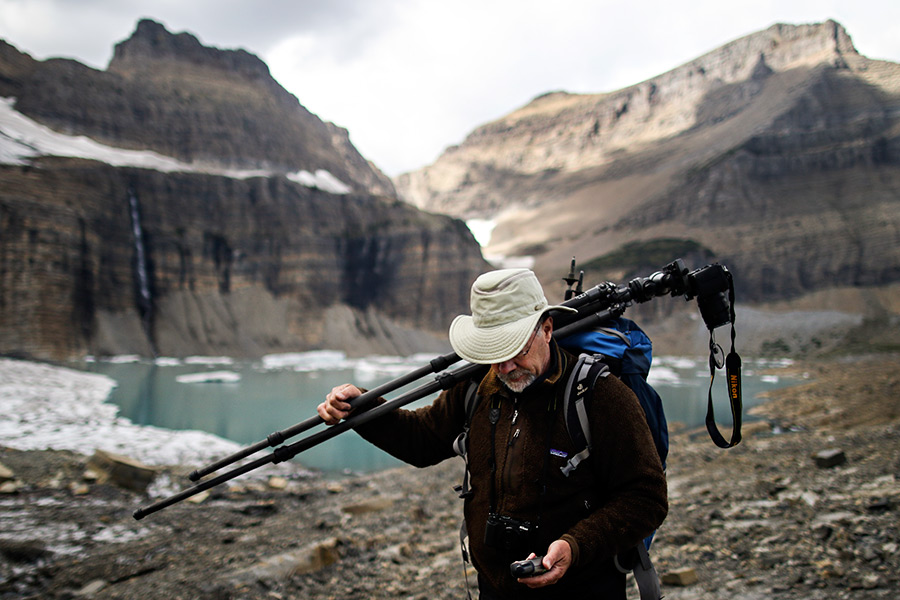GLACIER NATIONAL PARK – Standing just a few feet away from the icy mass of the Grinnell Glacier it is hard not to be awestruck by the scene unfolding before you.
Across the chilled glacial lake an amphitheater of mountain peaks reaches for the crystal blue sky. Turn around and the lush Swiftcurrent Valley sprawls out, offering views that on clear days can reach the wide-open plains of the Rocky Mountain Front.
In this small corner of a national park, each turn reveals a view seemingly more spectacular than the next. In this place, dropped jaws and wide eyes are the rule. It’s a fact that makes Daniel Fagre’s body language all the more perplexing.
Wandering in circles through the debris field left behind by the ever-shrinking glacier, Fagre has his nose buried in a GPS device and barely pauses to take in the scenery. But if you think the 62-year-old man is uninterested in the glacier you’d be wrong. In fact, he’s fascinated by it.
Fagre is one of the foremost climate change scientists in the United States. For the last 25 years, he has led a group of scientists studying one of the most iconic examples of that change in North America: the melting glaciers of Glacier National Park.
In his role as research ecologist and climate change research coordinator for the U.S. Geological Survey’s Northern Rocky Mountain Science Center, Fagre has written three books and dozens of scientific articles. He has given countless interviews to journalists from around the world and has even guided a vice president in the park. He has also had a major role in organizing a repeat photography project illustrating the dramatic changes that have taken place in Glacier National Park in the last century. The photos have been published around the world and featured in art exhibits.
“You don’t have to know anything about climate change or glacier recession to understand what is happening in these photos,” Fagre said, talking about how they are one of the most effective tools in telling the story of a warming world.
Fagre graduated from Prescott College in Arizona in the 1970s and later attended the University of California – Davis, where he received a doctorate in animal ecology and behavior in 1981. In 1990, President George H.W. Bush signed the Global Change Research Act that required federal agencies to start researching climate change and related issues. The mandate helped create the USGS Climate Change in Mountain Ecosystems program and Fagre arrived in Glacier Park the following year to help spearhead the research there.
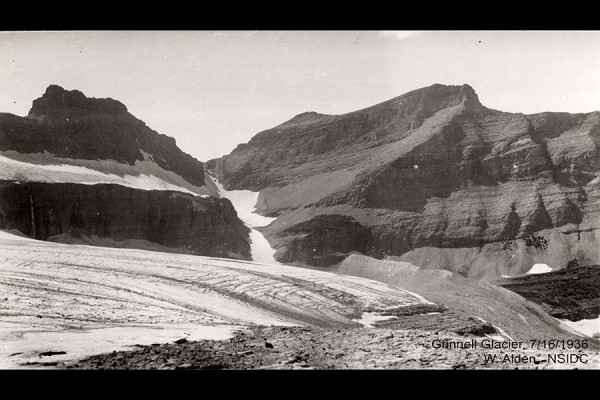
America’s national parks were selected as laboratories because they are some of the few landscapes relatively unchanged by humans. Glacier in particular was selected because of its namesakes, which, according to Fagre, “act like a checking account for the climate.” In 1850 there were more than 150 glaciers in the park, but today there are just 25 and within a few decades, all of the glaciers will be gone. In order for a body of ice to be considered a glacier it must be at least 25 acres and slowly sliding toward sea level.
But Fagre focuses on more than melting glaciers. He has dedicated most of his research time to seeing what impacts climate change is having on mountain ecosystems as a whole. Among the issues Fagre and his small team have studied include changes to alpine vegetation, snowpack and avalanches. In one recent study, Fagre’s team studied pollutants in snow samples. Much to their surprise, the snow included chemicals like Dichlorodiphenyltrichloroethane, which are banned in the United States but are still used in parts of Asia; meaning they arrived in Glacier through Trans-Pacific weather patterns. Fagre’s likened his research to a good detective novel.
“The questions pile up much faster than answers and the more you study the more you start asking questions about this, that and the other. It’s an endlessly fascinating story,” he said.
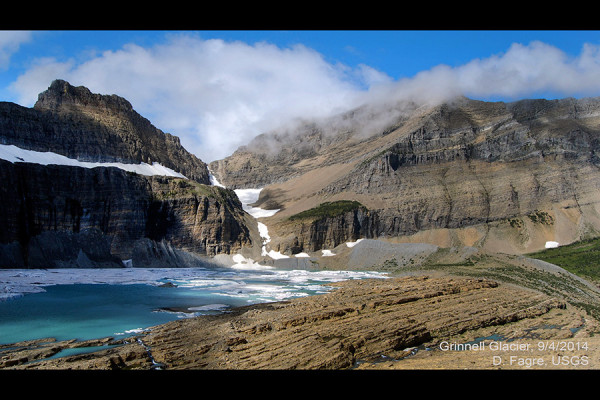
In many ways, Fagre has become the spokesperson for climate change in Glacier Park, having appeared in dozens of newspaper and magazine stories over the last decade. In 1997, he guided Vice President Al Gore to the Grinnell Glacier (on a recent trip to the glacier, he pointed out the massive rock the vice president hid behind to change out of his sweaty shirt before speaking to the media).
A colleague, Erich Peitzsch, said one of Fagre’s greatest talents is being able to “translate science to any audience.” Peitzsch, who has worked with the USGS since 2007 and is also director of the Flathead Avalanche Center, said the skill is especially important because it’s easy for people to get lost and confused in dense scientific data.
“He is a wealth of knowledge,” Peitzsch said. “There is no shortage of information from Dan.”
But sometimes the most complex issues can be conveyed in a photograph. Fagre and others at the USGS office in West Glacier have spent years working on the glacier recession repeat photography project. Fagre said someone with the National Park Service first showed him before and after photos of some of the park’s glaciers more than 20 years ago and the differences shocked him.
Since then he has worked with Lisa McKeon, a USGS physical scientist who has been at Glacier since 1997, on gathering historic photos and then going out and repeating them to show just how much the glaciers have changed. The photos have been used in textbooks, documentaries and even in an Italian shoe catalog.
“People have found some really creative uses for our photos and that’s great,” he said. “We have all of our science papers in PDF form online but no one downloads them. But there are days where 8,000 people have looked at our repeat photos online.”
While the photos are critical in conveying information, Fagre is now also using them to gather data; specifically, he has taken repeat photos of Grinnell Glacier to see if it’s still moving.
On a clear August morning – a rarity this wildfire-filled summer – Fagre swung a loaded backpack over his shoulder at the trailhead not far from the Many Glacier Hotel and began the six-mile hike to Grinnell. Fagre said he has lost count of how many times he’s been to Grinnell but know he has made at least one trip to the glacier every year since 1996. The days in the field are always his favorites.
“This is a lot more fun than all the other stuff I need to do back at the office,” he said.
After a few hours of hiking, Fagre approached an area called Elrod Rock (the same rock Gore changed behind 18 years earlier). The rock is named for naturalist Morton J. Elrod, who more than a century ago used it as a landmark to measure how much the glacier had shrunk. Every time he returned, Elrod measured how many paces it took to get from the rock to the glacier. Back then, it wasn’t a long walk to get to the foot of the glacier, but today it is more than a mile away.
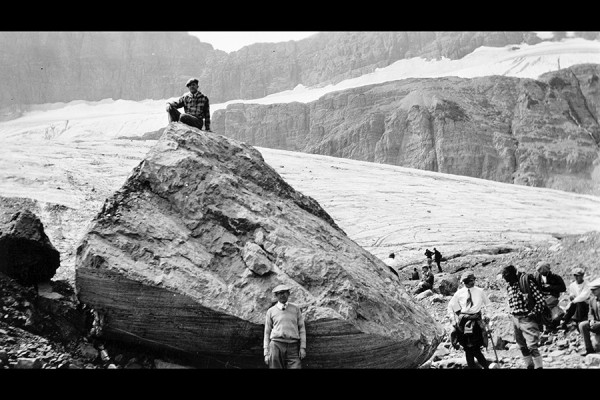
Fagre said the changes at Grinnell over the last 25 years are staggering. When he first started studying the glacier, its face reached 25 feet into the air, but today you’re more likely to bump your knees with the top of it when you approach. Even a decade ago, the glacier was so large a Maryland man died of hypothermia when he fell into a 40-foot crevasse.
“It used to feel like a real glacier but it doesn’t seem like much of one now,” Fagre said on the approach. “It looks different every year.”
Upon arriving at the glacier, Fagre scarfed down a peanut butter and jelly sandwich and then set up his tripod. The process is more complex than you would expect. Fagre used a GPS device to determine the exact spot he stood two years ago for the last repeat photo. Once he finds the location, he puts the tripod down and then takes out a folder of photos to compare the composition of the last frame and the exact location of the tripod two years earlier. Often the act of finding the photo location is much longer than actually taking the photo. But it’s not because Fagre isn’t adept at finding his previous mark, it’s because the landscape has changed dramatically even in just a few years. The snowpack, which can be 40 or 50 feet deep, can easily move rocks and rubble wherever it pleases.
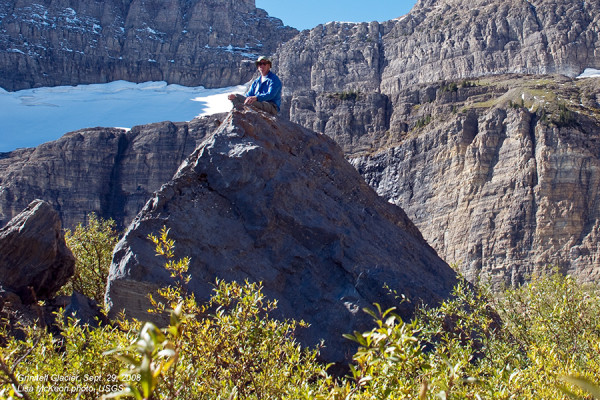
Once the camera is set up, Fagre takes a photo and spins the camera to capture five or six more frames, which will all be stitched together to form one panoramic image. Before the first image is exposed, Fagre said there are already noticeable differences between the photos taken in 2013 and the scene in 2015. For one, in just two years the glacier has receded more than 50 feet in some places, evidence that the strengthening El Nino is already taking its toll.
However, the photos also reveal some good news: Grinnell is still a glacier, as evidenced by a massive boulder that had moved 40 or 50 feet in the last two years. The fact that the glacier is still moving was confirmed not long after Fagre arrived when a muffled boom could be heard from within the mass of ice, the sound of the glacier slowly moving downhill.
“This glacier still has some legs under it after all,” Fagre said.
After four hours of photographing the glacier (and a quick break to take a photo with some hikers who recognized him as a “celebrity of Glacier Park”), Fagre packed his bag and prepared for the six-mile hike back to his car. After that, it was a two-hour drive home to West Glacier. Fagre said days in the field can be exhausting, but that the information they provide can be priceless – “there is something to be said for seeing the beast on the ground.”
Fagre makes about six or seven trips to the glaciers every year. The most labor-intensive trek is to Sperry every spring when snow still covers most of the route. Fagre and a group of researchers will usually spend two or three days in the field and can only get to the glacier on skis. The goal of the early spring trip is to measure how deep the snowpack is. They return to the glacier at the end of the summer to see how much has melted, which tells them if the glacier is growing or shrinking. More often than not, the glacier is receding at an ever-quickening pace.
Fagre said it’s not a matter of if the glaciers of Glacier Park will be gone, but a matter of when. However, he is hesitant to estimate an exact date when they will reach a vanishing point.
“We want to get away from putting a date on when the glaciers will be gone. We want to inform people of the process and how it is happening right now,” he said. “Will the glaciers be gone in 2037 or 2040? Who knows, but they will be gone within our lifetime.”
At 62 years old, a time when many people would start contemplating retirement, Fagre said he has plenty of things to keep him busy for the next few years. Even when he does step back from the research that he has been doing for nearly a quarter century, Fagre is confident it will continue, as other scientists step up to catalog a critical record of Glacier Park’s most iconic features.
“When I feel like I’ve gotten a few projects wrapped up then I’ll think about retirement,” he said. “But until then I’m just going to keep my head down and keep working.”
